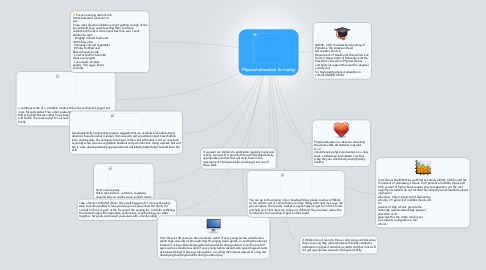Physical education for today
by Tabatha Dobson

1. a nutritious snack of a smoothie made with berries and low-fat yogurt has more fat and calories than a diet soda and baked chips; however, it is far better for kids because it has many beneficial nutrients they need for growth and health. The reason why? It's a snack of nutrient-rich, Five-Food-Group foods.
2. Host a dance party. This works indoors, outdoors, anywhere, anytime. All you need is some jammin' music.
3. Take a family stroll after dinner (try a walking game for more active play), walk to school and back, take your dog on a spin around the block, do errands on foot or park at the far end of the parking lot. Consider outfitting the whole family with inexpensive pedometers, then tracking your steps together. Set goals and reward yourselves with a family outing
4. If we want our children to participate regularly in physical activity we must first provide them with developmentally appropriate activities that will assist them in the development of physical skills. Catching is but one of those skills.
5. Over the past 20 years we have created a world of very young techno wizards who spend huge amounts of time watching TV, playing video games, or surfing the Internet instead of using and developing their physical skills during outdoor Over the past 20 years we have created a world of very young techno wizards who spend huge amounts of time watching TV, playing video games, or surfing the Internet instead of using and developing their physical skills during outdoor play.
6. Developmentally appropriate practice suggests that we as adults make educational decisions based on what is known from research and experience about how children learn and develop. For example, learning to strike a ball with a bat is not an easy task especially when we use a regulation baseball and a wooden bat. Using a plastic ball and bat is more developmentally appropriate and will initially better help the child learn the skill.
7. You can go to the skating rink or bowling! Many places now have YMCA’s or fun centers and of course there are many hiking trails near me so we can go see nature. The farmers market is a great place to get farm fresh foods and help your local economy, take your child and they can learn where the food comes from and how it gets on their plate!
8. Focus on eating nutrient-rich foods instead of what not to eat. Since most American children are not getting enough of the key nutrients they need, teaching them to choose nutrient-rich foods is more important than ever. Teach children to spot: ◦ Brightly colored fruits and 100% fruit juice ◦ Vibrantly colored vegetables ◦ Whole, fortified and fiber-rich grain foods ◦ Low fat and fat-free milk, cheese and yogurt ◦ Lean meats, skinless poultry, fish, eggs, beans and nuts.
9. In its School HealthPolicies and Practices Study (2006), CDC found that 63 percent of elementary schools, 83.9 percent of middle schools and 95.2 percent of high schools require physical education, yet the vast majority of students do not receive the nationally recommended amount of physical education. Only 3.8 percent of elementary schools, 7.9 percent of middle schools and 2.1 percent of high schools provide the nationally recommended daily physical education or its equivalent for the entire school year for students in all grades in the school.
10. Physical education is critical to educating the whole child. All students in grades K-12 should receive physical education on a daily basis. students perform better in school when they are emotionally and physically healthy.
11. NASPE, CDC, the American Academy of Pediatrics, the American Heart Association, the U.S. Department of Health and Human Services, the U.S. Department of Education and the President’s Council on Physical Fitness and Sport all support the need for physical activity and for high-quality physical education in schools (NASPE, 2010).
12. If children do not learn to throw, catch, jump and kick when they are young they will not possess the skills needed to participate in physical activities as adults and thus most will not get appropriate amounts of physical activity.


